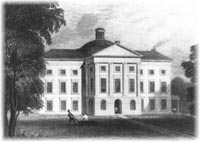
State House (1794, burned 1831), Raleigh
|
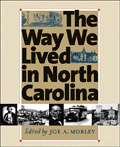


THE CULTURE OF THE REPUBLIC . . .
CHAPTER EXCERPTS
 andmarks of the War for Independence survive in every part of North Carolina. Moore's Creek National Military Park, in Pender County, commemorates the battle site of a 1776 American victory over Tory Highland Scots. Guilford Courthouse National Military Park, in Guilford County, commemorates Lord Charles Cornwallis's Pyrrhic victory over the Americans under General Nathanael Greene in 1781. But the cultural monuments of independence, though less conspicuous than the battlefields, are even more significant. When the shooting died away, North Carolinians continued to work out the meaning of independence in the fabric of their daily lives and to fulfill the seemingly profound opportunities and obligations that liberty brought them. andmarks of the War for Independence survive in every part of North Carolina. Moore's Creek National Military Park, in Pender County, commemorates the battle site of a 1776 American victory over Tory Highland Scots. Guilford Courthouse National Military Park, in Guilford County, commemorates Lord Charles Cornwallis's Pyrrhic victory over the Americans under General Nathanael Greene in 1781. But the cultural monuments of independence, though less conspicuous than the battlefields, are even more significant. When the shooting died away, North Carolinians continued to work out the meaning of independence in the fabric of their daily lives and to fulfill the seemingly profound opportunities and obligations that liberty brought them.
As they shaped their new commonwealth, the state's citizens tried to follow the same principles that had led them initially to independence. The Provincial Congress made North Carolina a republic when it declared "that all political power is vested in, and derived from, the people only." Beginning as a political description, "republican" came to be a cultural standard that North Carolinians tried to apply to every institution in their society. When the citizens thought that their families, churches, schools, and economic arrangements were truly republican, they sought to protect that fragile quality from the hostile forces of a changing world. If they thought their institutions failed to measure up to republican standards, the citizens sought appropriate reforms. The struggle to establish and maintain an independent republican society was the pervasive theme in North Carolina's history from 1770 to 1820.
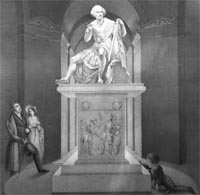
Italian sculptor Antonio Canova's statute of George Washington was destroyed when the State Capitol was destroyed by fire in 1831. The Washington statute in the present State Capitol (1834-40) is a marble copy made in the 1960s.
|
The most outstanding product of the cult of classical antiquity was the larger-than-life-size statue of George Washington that the legislature authorized in 1816. Completed by the great Italian sculptor Antonio Canova, the statue depicted the father of his country in the garb of a Roman general who has turned from the exercise of the sword to the arts of peace. Seated on a stool, the statesman was shown in the act of composing laws for the good of his countrymen. The figure of Washington touched a deep chord of emotion among North Carolinians; the Raleigh Register called it "that proud monument of national gratitude, which was our pride and glory," and most of its viewers seem to have agreed. As a work of political art, the sculpture was heavily didactic, and, according to a later legislative report, its message was plain. "While it refuted the calumny which stigmatizes republics as ungrateful," the solons declared, "it taught that true glory is the meed of virtue, and that, though temporary popularity may be gained by courting public favor, permanent renown, the renown which triumphs over the grave, is awarded to him alone who seeks the public good with pure and devoted disinterestedness." The citizens placed the image of Washington in the rotunda of the State House, where it silently demonstrated to legislators and visitors alike the glory of republican government and the qualities expected from an ideal republican statesman.
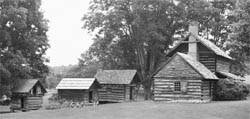
Birthplace (ca. 1795) of Zebulon B. Vance, Buncombe County.
|
David Vance was one of the settlers who chose the North Carolina side of the mountains. A veteran of the Continental Army and the Battle of King's Mountain, Vance came to the Reems Creek area of Buncombe County between 1785 and 1790 to work as a teacher, lawyer, and land surveyor. He purchased a farm from William Dever in 1795 that is now maintained as the birthplace of Zebulon Baird Vance, David Vance's grandson and the Civil War governor of North Carolina. The house on the property was built of logs, but it was larger and more elaborate than the typical settler's cabin, for David Vance was more prosperous than the average settler; he was a slaveholder who became first clerk of court for Buncombe County, colonel in the county militia, and representative in the General Assembly. The remote location of Colonel Vance's farm ensured that his family would continue to rely on traditional handicrafts to produce items for daily use in the home and on the farm. Once common in eastern and Piedmont North Carolina, these skills survived in the more recently settled mountains because the difficulty of access kept machine-made products at a distance until relatively late in the twentieth century.
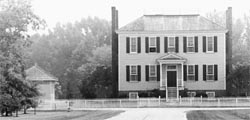
Hope Plantation (1796-1803), Bertie County.
|
Hope Plantation of Bertie County is a particularly striking example of North Carolina's expanding plantation society. Hope was the home of David Stone (1770-1818), U.S. senator and governor of North Carolina. He was the son of Zedekiah Stone, a Cashie River merchant and planter who had migrated from Massachusetts in 1766. A promising young man with good looks, impressive talents, and valuable connections, David Stone graduated from Princeton with highest honors and read law under his fellow Princetonian William Richardson Davie of Halifax. Before Stone turned twenty, Bertie County freemen had sent him to the state convention that ratified the U.S. Constitution in 1789. They followed this honor with continuous terms in the North Carolina House of Commons until 1794, when he won election to the bench as a superior court judge. Thereafter, Stone was never absent from public office until he left the U.S. Senate in 1814. Successively he was U.S. congressman, U.S. senator, judge again, governor of the state, member of the legislature, and once more U.S. senator. In spite of this long record of public confidence, Stone resigned from the Senate under fire, when his opposition to the War of 1812 stirred the anger of his North Carolina constituents. When he was only forty-eight, in 1818, Stone died at Rest Dale, his plantation in Wake County.
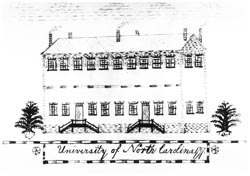
Drawing of the University of North Carolina's first building, Old East, as it originally looked to John Pettigrew, a student in 1797.
|
By 1819 religion had gained great prestige among the gentry according to the grandson of a North Carolina signer of the Declaration of Independence. In a sermon of that year preached to the well-heeled founders of the North Carolina Bible Society, the Reverend William Hooper recalled the days "when religion with downcast eye and timid step never ventured to approach the mansions of the opulent and elite, and only found casual entertainment among the cottages of the poor and ignorant." Hooper rejoiced with his audience that the churches "had grown respectable in the eyes of men" and had won the allegiance of "the men occupying the station and possessing the political influence of those who are now the patrons and pillars of our Bible Society." As North Carolina's commitment to evangelical religion deepened, the churches' style and doctrine became fixed features of the people's common culture. Beginning as a spiritual challenge to the established order, the churches in time became a part of it and gave their blessing to North Carolina's stable, agrarian, republican way of life.
The most conspicuous collaborative project of the planters and the evangelicals was the University of North Carolina. Led by General William Richardson Davie, prominent secular politicians believed that a university to train each rising generation of the elite in the principles of science, reason, and virtue would be an incomparable asset for the future of North Carolina. Prominent Presbyterian clergy, inspired by the Reverend Samuel E. McCorkle, hoped that a religiously oriented school would train future ministers in Greek, Latin, and moral philosophy, while preparing other godly youths for honorable service in diverse fields. Both groups urged the legislature to act, and the University of North Carolina was the result.
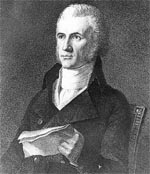
General William Richardson Davie.
|
Chartered in 1789, the college opened in 1795 as the first state university in America. McCorkle devised the first curriculum; it stressed moral education and the classical languages of Latin and New Testament Greek. A little later, the trustees substituted a different course of study proposed by Davie. The new curriculum was more practical, stressing modern languages and mathematics. A student could, if his parents chose, avoid the "dead" languages altogether and earn an English diploma that was based on the study of science and mathematics and their practical applications. In Davie's view, there was more virtue to be found in skills useful for the new country than in the ambiguous speculations of philosophers, theologians, and dead poets. Under the Reverend Joseph Caldwell, the university's second president, a compromise was struck that provided for more secular versions of the traditional classical subjects.
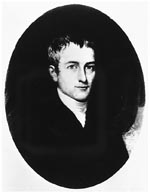
Archibald D. Murphey.
|
The outstanding reformer Archibald D. Murphey had a similar message for the 1815 General Assembly. "The time has come," intoned the senator from Orange County, "when it behooves the legislature of North Carolina to provide efficiently for the improvement of the inland navigation of the state. To delay this provision is to postpone that national wealth, respectability, and importance which only follow in the train of great internal improvements." When transportation costs were made lower by the construction of canals, Murphey argued, prosperity would ensue, and North Carolina could take its rightful place in the world of progressive republican independence.
The visions of Nathaniel Macon and Archibald Murphey were radically different, but both were logical versions of North Carolina's republican ideals. Both stressed the independence of the individual white freeholder and promised to guard his world from external assault and internal corruption. Macon sought to protect the institution of slavery by sealing off the influence of destabilizing social change. Equally devoted to slaveholders' interests, Murphey sought to strengthen the plantation economy by cutting the planter's freight rates and by enabling the isolated yeoman to sell the crops and buy the slaves that would raise him to planter status too. Each in his own way, Macon and Murphy were legitimate heirs of North Carolina's eighteenth-century republican heritage.
|

